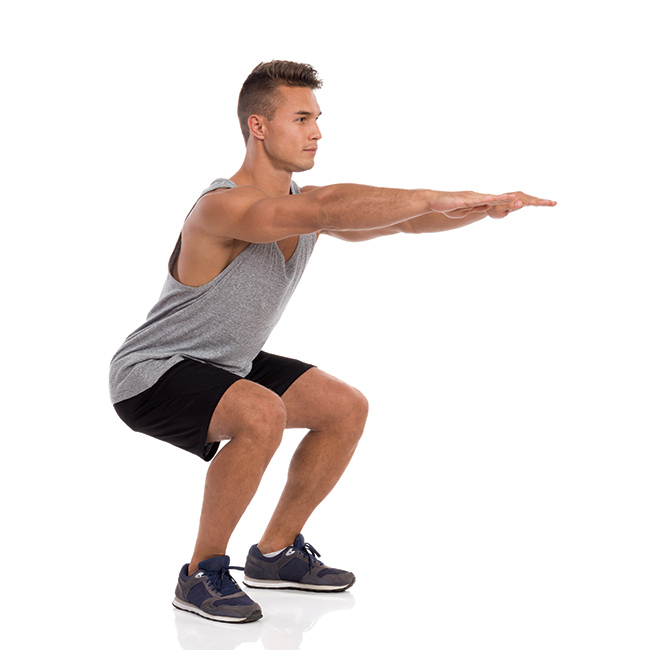BEFORE WE GET INTO THE SCIENTIFIC NITTY-GRITTY, LET’S DO A LITTLE EXPERIMENT. STAND UP RIGHT NOW AND DO 10 RAPID HINDU SQUATS. (FOR THOSE WHO DON’T KNOW, THIS IS A DEEP KNEE BEND THAT IS FAVORED IN THE GRAPPLING ARTS.) MAKE SURE YOU DO 10 OF THEM HARD AND FAST. NOW IT’S TIME FOR A QUICK SELF-ASSESSMENT. HOW DO YOUR LEGS FEEL?
by Mark Hatmaker
There is a possibility that your lungs puffed a wee bit and that your heart rate rose, but I’ll wager that the low number of repetitions did not make any fatiguing demands on your legs. They’re probably good to go for another 10.
Since what you’re feeling is not leg fatigue but more likely related to elevated heart and respiration rates, do 10 more — but this time, I want you to time them a little differently.
Rather than 10 hard and fast Hindu squats, go leisurely. Drop down for the first repetition and stay there for one minute before you return to standing. Repeat for a total of 10 squats.
I’ll wager the majority who submit to this experiment will do the first set of fast squats with no problem but will become a bit bored by the slow ones. However, it is the bodily sensations accrued by the second set that will pave the way for today’s lesson.
Now, whether you did the experiment or not, here’s the upshot. The hard and fast set of 10 squats will feel noticeably less taxing than the slow set. Why should this be? After all, in the slow set, you’re essentially in a resting position — the deep squat, aka the third-world squat.
The difference in effort is not one of mere perception; it is one of biomechanical function. When you squat with speed, the extensor muscles, although no longer required to remain standing, stay under tension all the same to control the rate of descent.
In the fast iterations of the squat in which an immediate turnaround is required (rising back to standing), the extensors still under load are able to increase the present tension and make the rapid rise easily. In the slower iterations, you stop at the bottom, and the extensors, which were under load during descent, disengage. In other words, the tension decays.
To return to standing, you must place them back under load, walking the scale back up from 0 percent to full use.
Fast iterations of the squat allow the leg musculature to use “elastic loading” in which your extensors behave like rubber bands stretched and tensed for use. Slow iterations involve slack rubber bands that require full muscular engagement with zero elastic aid.
Elastic recoil aids speed and conserves energy. When you run, the associated calf muscles and Achilles tendon do not go to zero slack as a foot peels off the ground with each stride. There is still tension loaded in the toes, the feet, the Achilles tendons and the calf muscles, and that allows for elastic rebound once the next foot is placed on the ground.
Here’s another experiment: Sprint 50 yards as hard and fast as you can. At the conclusion, note your internal state. I’ll wager, just as with the fast squats, that you’ll have elevated respiration and heart rates. However, running 50 yards at full speed will not be experienced as taxing on your legs.
Now, cover that same 50 yards, but this time, take one bounding step and land on one foot‚ pause for three seconds, bound to the next foot and so on. It’s important that when you’re making these giant steps, you land with a flexed knee and remain in knee flex, which one would assume would aid the bounding task. However, the three-second pause allows for elastic decay.
After this is complete, again note your internal state: elevated respiration and heart rates and likely a remarkable increase in perceived leg exertion in comparison to the sprint.
Now let’s tie this in to combat — or any athletic endeavor. When your stance forces you to start from stock-still, by biomechanical definition, you cannot use elastic loading for speed or energy conservation. Any footwork of the slow, plodding variety will not use elastic load or, at the very least, will entail small elastic load assistance. Static stances and deliberate footwork are by definition slower and ultimately more taxing.

I’m not advocating the use of bouncing or bounding footwork in which you are barely in contact with the ground. That’s always unwise. Such overactivity can lead to inefficient energy expenditure, and the reduced contact with the ground makes weight transfers and direction changes less efficient.
What you may find, however, is that there’s a better method of movement that takes advantage of elastic load in a way that improves your speed and reduces muscle fatigue. It’s up to you to determine precisely what that method is and whether it meshes with your chosen martial art.
Mark Hatmaker’s website is
extremeselfprotection.com
![]()
